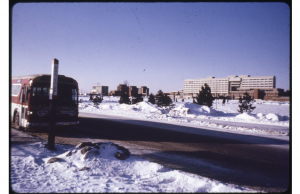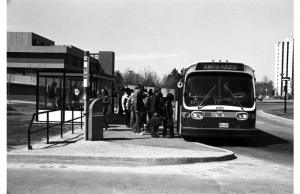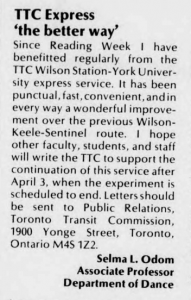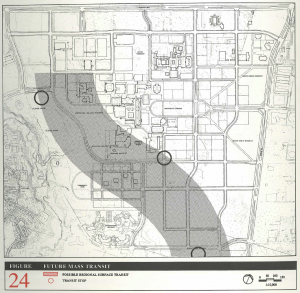
Mel Hamill composed The Toronto Subway Song in 1950 during the construction of the city’s first subway.
In less than a week, travel to the university will reach rocket speeds with the opening of two subway stations on campus.
While the commute nowadays may be described as rough, try and think back to the opening of Keele Campus in 1965 when the Bloor-Danforth line was still under construction. In fact, back then, the subway climbed no further north than St. George and Eglinton stations!
The commute to York University sure has changed over the years.
Limited service, long commutes, and a hike to campus (1965-1972)
Coinciding with the arrival of the first cohort of students, the Toronto Transit Commission (TTC) established the 41 Keele route which ended, not at a subway station, but Davenport Road and Lansdowne Avenue. Around the same time, to better serve the area the 36 Finch service was extended to Weston.[1] It would take four more years before the 60 Steeles route was inaugurated in 1969. Commutes often required multiple transfers to reach the university.
In a letter from 1970 to university president David Slater, a graduate student described how hitchhiking quickened his commute to campus:
It takes from eight to ten minutes to get from where I live to the university by car. [...] The average time over the same distance by bus is forty five minutes. Most of the time was taken up waiting for buses since two transfers are necessary and the busses on the three routes (Dufferin, Finch and Keele) are not co-ordinated. I got tired of waiting at bus stop, especially in the rain and cold, so I am now hitchhiking daily to and from the campus. I can usually get to the university in less than thirty minutes [...]. [2]
After the long commute, riders faced a one-kilometre trek to campus from the closest bus stop at Keele Street. Without Schulich, York Lanes, and the East/West Accolade buildings to block the wind, the walk would have been a chilly one!

As far as the Ross Humanities Building appears in this photograph of the Keele Street bus stop, the walk probably made it feel even further in the distance. York University Libraries, Clara Thomas Archives and Special Collections, Department of Campus Planning fonds, ASC35984
If you were lucky, during rush hours on weekdays, you could catch the 41B route which circled the campus on Fraser Drive (now primarily Ian MacDonald Boulevard and Pond Road).

Would you choose a shorter walk to catch the local bus on Fraser Drive (pictured), or the hike to Keele Street to catch the express service (above)? York University Libraries, Clara Thomas Archives and Special Collections, Department of Campus Planning fonds, ASC35856
Seeing these images, one can understand why students, staff, and faculty often advocated for increased service with initiatives such as a campus-wide petition organized by the Excalibur to "get York put on a full-time route".

Advocacy initiatives included this campus-wide petition organized by Excalibur. Smith, Jim. Excalibur. "T.T.C. Petition." Excalibur, 10 February 1967.
One dream, three decades, four subway expansions(1973-1999)
After the cancellation of the Spadina Expressway in 1971, students believed mass transit to campus would soon follow and they were partially correct.[3] During the 1970s, the TTC extended the subway northbound three times. First, in 1973, the Yonge line climbed to York Mills station and then, a year later, to Finch station.

Note the Wilson station on the bus label from this photograph in front of the Ross Humanities. York University Libraries, Clara Thomas Archives and Special Collections, Computing and Network Services fonds, ASC00270

A call to write letters to support express service.
With the third extension in 1978, from St. George to Wilson station, the commute now followed today’s popular route to campus with three exceptions:
- The newly established 106 York University route started at Wilson station, not Downsview.
- The bus shared public roads with traffic (the dedicated busway opened in 2009).
- Express service did not exist for another two years.
Fortunately, in 1980, the TTC decided to test ridership on an express service (the 106E) with a five-week trial period. During this time, the community successfully rallied for the continuation and expansion of the 106E.

The two proposed stations veer slightly southwest from today's subway stations.
With express service expediting the commute, the debut of two light rail stations in the York University Master Plan in 1987 aimed for direct service to the university.[4],[5] In the succeeding years, all university presidents advocated for a subway to York University. In 1992, the commuters were ecstatic about two victories:
- An announced subway expansion to the university (funding was withdrawn three years later).
- Regular bus service to York Lanes eliminated the hike to Keele Street.[6]

The 106E at York Lanes. York University Libraries, Clara Thomas Archives and Special Collections, Excalibur Publications Inc. fonds, ASC17500
Then, in 1996, the TTC expanded the Spadina line to Downsview station. With it, commuters avoided two long kilometres of traffic as the 106 relocated north to the new station. In 1999, those coming from Sheppard station rejoiced when the 106E was replaced with the 196 Rocket which took a more direct route to campus.
One more expansion makes all the difference (2000-2017)
When the busway opened as the GTA’s first major bus-only road in 2009,[7] the commute to Downsview shortened to a mere fifteen minutes – if there were no problems on Dufferin. More importantly, that same year, the TTC approved the York University station design concepts!
With tunnel boring for the subway extension beginning in 2013 and completing in 2016, the university community was that much closer to achieving their dream of a subway on campus.
While students are excited, we can also imagine that our researchers are excited about catching a ride on the subway to our reading room. Hope to see you soon!
References
[1] Calnan, John F. "041 Keele History Map." Transit Toronto. (Accessed November 11, 2017): 8. https://transit.toronto.on.ca/bus/routes/images/041-keele-history-map.pdf.
[2] York University Libraries, Clara Thomas Archives & Special Collections, Office of the President fonds (F073), Accession 1977-013/071 (2084). Accessed November 27, 2017. Letter from a graduate student to the University President. November 30, 1970.
[3] Spence, Edward. "The Spadina Subway Extension Through York University - Reflections on the Struggle for Approvals" in Contour Lines: York Geography Alumni Association (March 2013): 5. http://fesplanning.apps01.yorku.ca/wp-content/uploads/2012/03/CONTOUR-LINES-March-2013.pdf
[4] Five years earlier, a rapid transit system was included in a provincial bid for a Sportsplex on campus p.1 http://sve.canadiana.ca/view/carl.OTY_19831006/1?r=0&s=1
[5] York University, York Campus Master Plan. Corporate (Downsview: 1987), 10, quoted in Spence, Edward. "The Spadina Subway Extension Through York University - Reflections on the Struggle for Approvals" in Contour Lines: York Geography Alumni Association (March 2013): 10. http://fesplanning.apps01.yorku.ca/wp-content/uploads/2012/03/CONTOUR-LINES-March-2013.pdf
[6] After a gradual increase from the introduction of evening drop-offs at the Ross Humanities Building in 1987.
[7] Marshall, Sean. "York University Busway: Below the Radar." Spacing Toronto (Accessed November 11, 2017). http://spacing.ca/toronto/2009/12/27/york-university-busway-below-the-radar/
Additional Reading
Bayazitov, Dennis. "A brief history of transit at York." Excalibur: York University's Community Newspaper. Accessed November 23, 2017. http://excal.on.ca/a-brief-history-of-transit-at-york/

